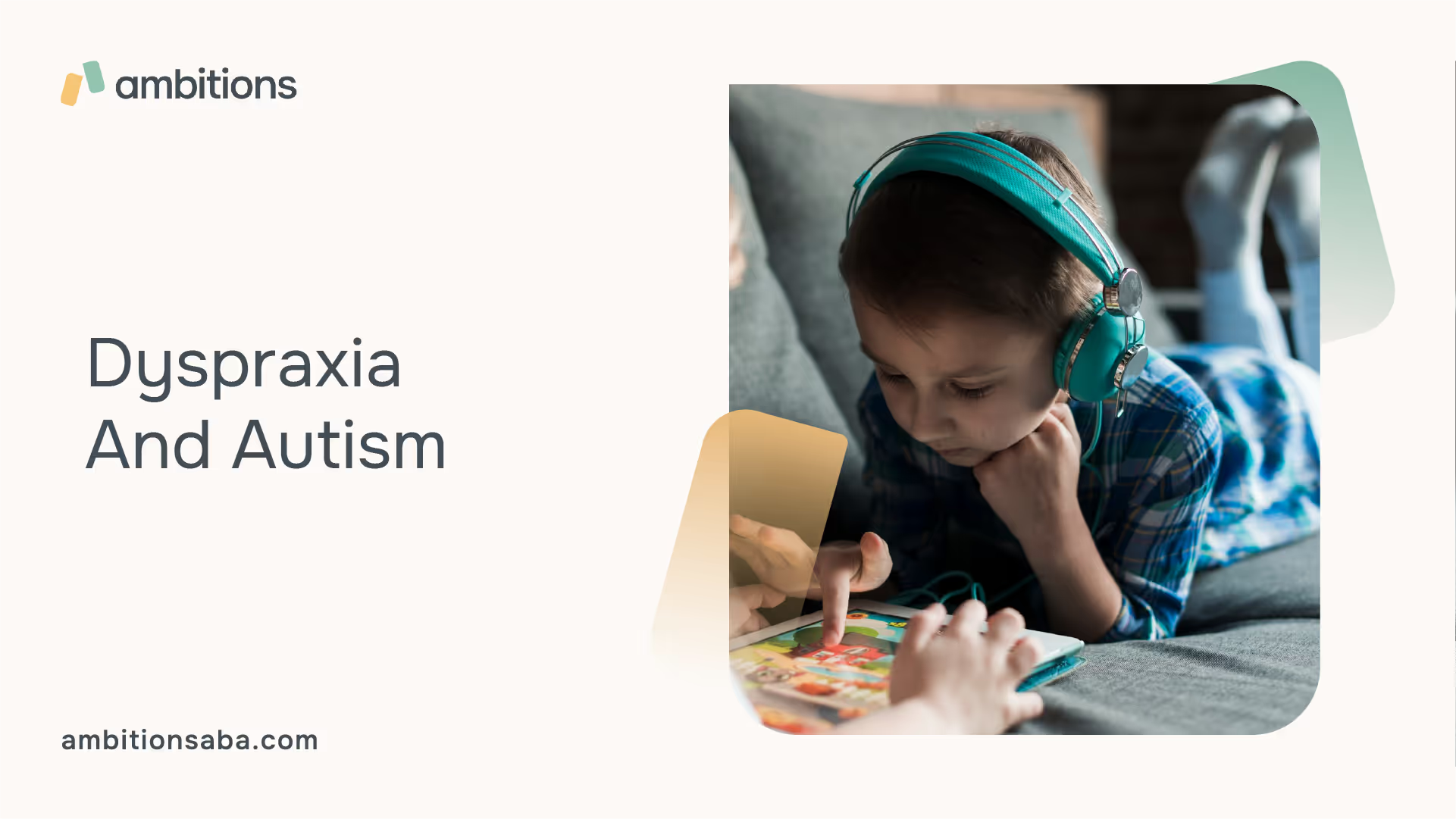Empowering Parents with the Essentials of Visual Supports
Dyspraxia And Autism
To navigate the journey of dyspraxia and autism diagnosis, it's important to first understand the conditions individually, as well as the overlap between them. Dyspraxia and autism are neurodevelopmental disorders that can coexist and present unique challenges for individuals and their families.

What is Dyspraxia?
Dyspraxia, also known as Developmental Coordination Disorder (DCD), is a condition that affects motor coordination and planning. Individuals with dyspraxia may experience difficulties with activities that require coordination and fine motor skills, such as tying shoelaces, writing, or participating in sports. Dyspraxia can also impact speech and language development, as well as organizational skills.

What is Autism?
Autism, or Autism Spectrum Disorder (ASD), is a complex neurodevelopmental condition characterized by challenges in social interaction, communication, and repetitive behaviors. Individuals with autism may have difficulties in understanding and responding to social cues, maintaining eye contact, and engaging in reciprocal conversations. They may also display repetitive behaviors or restricted interests.
The Overlap between Dyspraxia and Autism
Dyspraxia and autism often coexist, with research indicating a significant overlap between the two conditions. Many individuals with autism also exhibit motor coordination difficulties associated with dyspraxia. Conversely, individuals with dyspraxia may display social communication challenges and repetitive behaviors commonly seen in autism.
It's important to note that the presence of dyspraxia does not necessarily indicate an autism diagnosis, and vice versa. However, the co-occurrence of these conditions can complicate the diagnostic process, as the symptoms can overlap and interact with each other.
If you suspect that your child or a loved one may have dyspraxia and autism, it is essential to seek professional evaluation from healthcare providers or specialists experienced in diagnosing neurodevelopmental disorders. Assessments may involve detailed observations, interviews, questionnaires, and standardized tests to evaluate various aspects of motor skills, social communication, and behavior.
By understanding dyspraxia and autism and their overlap, you can better support individuals with these conditions and help them thrive by accessing appropriate interventions, therapies, and support networks.
Signs and Symptoms
To better understand the link between dyspraxia and autism, it's important to recognize the signs and symptoms associated with each condition. While dyspraxia and autism are distinct conditions, they can sometimes coexist, leading to overlapping symptoms. Let's explore the common signs of dyspraxia, the common signs of autism, and the symptoms that may be present in both.
Common Signs of Dyspraxia
Dyspraxia, also known as developmental coordination disorder (DCD), primarily affects motor coordination and can manifest in various ways. Some common signs of dyspraxia in children and adults include:
- Difficulty with fine motor skills, such as tying shoelaces or using utensils
- Poor hand-eye coordination, leading to challenges in activities like catching a ball
- Awkward or clumsy movements
- Difficulty with planning and organizing tasks
- Challenges with spatial awareness and depth perception
- Sensory processing issues, such as sensitivity to noise or touch
Common Signs of Autism
Autism, or autism spectrum disorder (ASD), is a neurodevelopmental condition that affects social interaction, communication, and behavior. Here are some common signs of autism in children and adults:
- Difficulty with social interactions and communication, such as maintaining eye contact or understanding social cues
- Repetitive behaviors or restricted interests, such as lining up objects or intense fascination with a specific topic
- Challenges with verbal and nonverbal communication, including delayed speech or difficulty understanding gestures
- Sensory sensitivities, such as being bothered by certain sounds or textures
- Difficulty with transitions or changes in routine
Overlapping Symptoms
Due to the shared characteristics of dyspraxia and autism, there can be overlapping symptoms in individuals with both conditions. Some of these overlapping symptoms may include:
- Motor coordination difficulties, such as challenges with handwriting or tying shoelaces
- Sensory sensitivities, including heightened reactions to certain sounds, textures, or lights
- Difficulties with social interactions, such as interpreting nonverbal cues or maintaining appropriate personal space
- Communication challenges, such as difficulties with expressive or receptive language skills
It's important to note that the presence of overlapping symptoms does not necessarily indicate a diagnosis of both dyspraxia and autism. Seeking a professional evaluation is crucial for an accurate diagnosis.
By recognizing the signs and symptoms associated with dyspraxia and autism, you can better understand the link between these conditions and navigate the journey of diagnosis and support for yourself or your loved one.
Diagnosis Process
Receiving a proper diagnosis is crucial for individuals suspected to have both dyspraxia and autism. This section explores the process of diagnosis, including seeking professional evaluation, assessments for dyspraxia and autism, and the challenges that may arise along the way.
Seeking Professional Evaluation
Parents or caregivers who notice developmental delays or atypical behaviors in their child should seek a professional evaluation. It is recommended to consult with healthcare providers, such as pediatricians, psychologists, or developmental specialists, who have experience in diagnosing neurodevelopmental disorders. These professionals can conduct a comprehensive assessment to determine if dyspraxia, autism, or both are present.
Assessments for Dyspraxia and Autism
The diagnosis of dyspraxia and autism involves a thorough evaluation of the individual's developmental history, behavior, and cognitive abilities. Professionals may use a combination of interviews, questionnaires, and standardized assessments to gather information and make an accurate diagnosis.
For dyspraxia, assessments often focus on assessing motor skills, coordination, and sensory processing. These evaluations may include tools such as the Movement Assessment Battery for Children (MABC) or the Bruininks-Oseretsky Test of Motor Proficiency (BOT-2). Additionally, professionals may observe the individual's fine and gross motor skills in various settings.
When assessing for autism, professionals typically rely on well-established diagnostic tools such as the Autism Diagnostic Observation Schedule (ADOS) and the Autism Diagnostic Interview-Revised (ADI-R). These assessments evaluate various domains of behavior, communication, social interaction, and restricted or repetitive patterns of behavior.
It's important to note that the diagnostic process may vary depending on the healthcare provider and the resources available in your area. The assessment may involve a multidisciplinary team, including psychologists, speech therapists, occupational therapists, and other specialists who collaborate to gather a comprehensive understanding of the individual's strengths and challenges.
Challenges in Diagnosis
Diagnosing dyspraxia and autism can be complex due to the overlap of symptoms and the heterogeneity of both conditions. Some challenges that may arise during the diagnostic process include:
- Variability in presentation: Dyspraxia and autism can present differently in each individual. This variability can make it challenging to distinguish between the two conditions, especially when symptoms overlap.
- Co-occurring conditions: Both dyspraxia and autism can co-occur with other neurodevelopmental disorders, such as attention-deficit/hyperactivity disorder (ADHD) or specific learning disabilities. Identifying and differentiating these conditions requires careful assessment and observation.
- Age-related differences: The diagnostic process may differ for children and adults. Early diagnosis in children often involves monitoring developmental milestones, while diagnosis in adults may focus more on retrospective evaluation of developmental history.
- Cultural and contextual factors: Cultural and contextual factors can influence the perception and expression of symptoms, making it important for healthcare professionals to consider these factors during the diagnostic process.
Despite these challenges, seeking professional evaluation and obtaining a comprehensive assessment can provide valuable insights into an individual's strengths and challenges, leading to appropriate interventions and support.
Navigating the Journey
When your child receives a diagnosis of both dyspraxia and autism, it can feel overwhelming. However, there are various strategies and resources available to support your child's development and well-being. Navigating this journey involves accessing supportive interventions and therapies, building a support network, and advocating for your child's needs.
Supportive Interventions and Therapies
Supportive interventions and therapies play a crucial role in helping children with dyspraxia and autism thrive. Occupational therapy (OT) is often recommended for children with dyspraxia as it focuses on developing motor skills, coordination, and sensory integration. OT can support your child in areas such as fine motor skills, handwriting, and self-care tasks. Additionally, speech and language therapy (SLT) can assist with communication challenges and social skills development.
For children with autism, applied behavior analysis (ABA) therapy is commonly used to address behavioral challenges and promote skill development. ABA therapy utilizes evidence-based techniques to teach and reinforce desired behaviors while reducing challenging behaviors. It can be tailored to target specific areas of need, such as communication, social interaction, and daily living skills.
Building a Support Network
Building a support network is essential for parents of children with dyspraxia and autism. Connecting with other parents who are on a similar journey can provide valuable emotional support, shared experiences, and practical advice. Seek out local support groups, online communities, and parent organizations that specialize in dyspraxia and autism. These communities can offer guidance, resources, and a sense of belonging. Remember, you are not alone in this journey.
Advocacy and Empowerment
Advocacy is crucial when navigating the journey of dyspraxia and autism. As a parent, you are your child's best advocate. It's important to understand your child's rights, access available services and support, and communicate effectively with professionals and educators. Be proactive in seeking appropriate educational accommodations, therapies, and inclusive environments for your child. By advocating for your child's needs, you can help ensure they receive the support they require to reach their full potential.
Empowerment is another vital aspect of this journey. Educate yourself about dyspraxia and autism, staying informed about the latest research, therapies, and strategies. By understanding your child's strengths, challenges, and unique abilities, you can help them navigate the world with confidence. Celebrate their achievements, no matter how small, and provide a nurturing environment that fosters growth and resilience.
Navigating the journey of dyspraxia and autism requires patience, perseverance, and a collaborative approach. Remember that each child is unique, and what works for one may not work for another. Stay open-minded, seek support, and adapt your strategies as needed. With the right interventions, support network, and advocacy, you can empower your child to thrive and embrace their differences.
Embracing Differences
When it comes to dyspraxia and autism, embracing differences is key to creating a supportive and inclusive environment. By celebrating neurodiversity, fostering strengths and resilience, and promoting inclusion and acceptance, we can help individuals with dyspraxia and autism thrive.
Celebrating Neurodiversity
Neurodiversity is the concept that neurological differences, such as those seen in dyspraxia and autism, are simply natural variations of the human brain. It emphasizes that these differences should be recognized, respected, and valued. By celebrating neurodiversity, we can challenge the notion of "normal" and appreciate the unique perspectives and abilities that individuals with dyspraxia and autism bring to the world.
Fostering Strengths and Resilience
Individuals with dyspraxia and autism possess a wide range of strengths and talents. By focusing on these strengths, we can help them build confidence and resilience. Some individuals may excel in areas such as creativity, problem-solving, attention to detail, or visual thinking. By providing opportunities for them to showcase their strengths and supporting their interests, we can help them thrive and reach their full potential. It's important to remember that everyone has unique strengths, regardless of their neurodiversity.
Promoting Inclusion and Acceptance
Promoting inclusion and acceptance involves creating an environment where individuals with dyspraxia and autism feel valued and accepted for who they are. This can be achieved by fostering understanding, empathy, and respect. Educating others about dyspraxia and autism, their symptoms, and the challenges individuals may face can help dispel misconceptions and reduce stigma. By promoting acceptance and inclusivity, we can create a world where everyone feels included and supported.
It's essential to understand that every person's journey with dyspraxia and autism is unique, and their needs and experiences may vary. By embracing differences, we can create a society that values the strengths and abilities of individuals with dyspraxia and autism.
FAQs
Can dyspraxia and autism be diagnosed at the same time?
Yes, it is possible to receive a diagnosis of both dyspraxia and autism. In fact, many individuals who are diagnosed with one condition are later found to have symptoms of the other.
Are there any early signs of dyspraxia or autism?
Yes, some early signs of dyspraxia can include delayed motor milestones such as crawling or walking, difficulty with feeding or dressing themselves, and poor handwriting. Early signs of autism may include lack of eye contact, delayed babbling or speaking, and a lack of interest in social interactions.
Can dyspraxia and autism be outgrown?
While these conditions cannot be cured or outgrown, individuals with dyspraxia or autism can learn strategies to manage their symptoms and improve their quality of life.
Is there a genetic component to dyspraxia and autism?
Yes, research has shown that there is a genetic component to both dyspraxia and autism. Individuals who have a family member with either condition may be more likely to develop it themselves.
Can someone have mild forms of dyspraxia or autism?
Yes, both dyspraxia and autism exist on a spectrum. This means that some individuals may have mild symptoms while others may have more severe symptoms. It's important for each individual to receive an accurate diagnosis so they can receive appropriate support.
Summary
Dyspraxia and autism are complex conditions that can affect individuals in different ways. While they are separate conditions, they often occur together. By understanding the connection between these conditions, we can better support individuals who are affected by them. With the right resources and support, people with dyspraxia and autism can thrive and reach their full potential.

